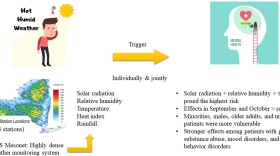The first New York State Mesonet site — in Schuylerville — is celebrating its 10th anniversary.
In August and September of 2011, Hurricane Irene and Tropical Storm Lee brought massive flooding and devastation across the Hudson Valley. In October 2012, Hurricane "Superstorm" Sandy battered the Eastern Seaboard with high winds, heavy rain and a storm surge of more than 13 feet, claiming 44 lives and displacing thousands. The storms and recent climate history leading up to them demonstrated a need for more advanced weather forecasting system that would be bolstered by existing weather data gathered from a variety of sampling points.
Mesonet systems originated from this kind of need. While one the earliest was set up in Oklahoma in 1994 following flooding in Tulsa, the University at Albany built New York’s first Mesonet site at Saratoga County’s Hudson Crossing Park in 2015. It’s now one of the country’s most advanced and powerful Mesonets.
Chris Thorncroft, who directs the Atmospheric Sciences Research Center at the University at Albany, helped set up New York’s system, which consists of 127 weather stations and has a presence in every county in the state.
"You're never more than around 19 miles away from a station. It's built to provide all types of weather information across the state in real time, updated every five minutes," said Thorncroft.
A $30 million FEMA grant helped pay for New York’s Mesonet. The system delivers real-time observations of rainfall, temperature, wind speed, wind direction, surface pressure and humidity, as well as soil moisture, soil temperature and snowpack.
Thorncroft said "The University of Albany achieved this through funding from FEMA in the wake of several important, big storms that affected New York, including especially Sandy and it was a $30 million FEMA grant and used to create the network."
Still, Thorncroft says, funding is a constant challenge, especially in the current federal climate. "A fraction of our budget is funded by something called the National Mesonet program, which is federal funds. So we're very cautiously looking at the news and what's going on. I think we're good for another 12 months at least. So that's good. I don't think anyone could be sure of what's going to happen after that. So we're watching, we watch the federal discussions very closely. I do believe that even with this federal government, there is a value given to the importance of weather data, for the reasons that are fairly obvious, both for real time situational awareness, but also getting that data into models that create better forecasts. So we're okay for now, but you can never be sure of the future."
Thorncroft points out that data provided via Mesonet benefits residents, businesses and farmers, and protects lives and property throughout New York state. He also notes the data are used by decision makers, particularly by the National Weather Service and Department of Homeland Security, for severe-weather notifications, response plans and disaster appraisals.
"It's led to earlier warnings than otherwise would have existed. So ideally we believe that we're making New Yorkers safer. There's something very special about this network. In addition to the 127 basic weather stations, we have a number of more sophisticated networks embedded within it. And the network that excites me the most is something called the profiler network. These are sensors that remotely sense the atmosphere above the ground up to about six miles. And so we've been doing work with that to get that data into models to improve forecasts," said Thorncroft.
Part of that ever-improving forecast comes from the harnessing of artificial intelligence – something that New York’s Mesonet has continued to do more and more over the last decade, Thorncroft says. "We're part of a national AI Institute which has been using AI to detect the weather in the cameras that we have to provide extra warnings. And we also have another project that's with another faculty member at ASRC, using the weather data and AI tools to make accurate, fast, Short Range weather predictions, specifically to do with wind and wind gusts. That's targeted, actually, at the energy industry. If you have a three hour to three to six hour warning on gusts, you know that that can affect how you deploy equipment or run renewable energy, so that that's completely AI based," he said.
And with the recent plague of wildfire smoke affecting New Yorkers, Thorncroft says the plan is to deploy air quality sensors on every weather station to create a real time air-quality map that updates every five minutes so that people across the state can make appropriate decisions.
In 2023, the DHS awarded the University at Albany $3 million for the Exploiting Mesonet for Emergency Preparedness and Response to Weather Extremes project, to improve emergency management and deliver accurate, real-time forecasting for severe weather. Last month, New York officials including Congressman Paul Tonko (NY-20) appealed to Department of Homeland Security (DHS) Secretary Kristi Noem urging the Trump Administration to reverse its decision to terminate funding for the project.








